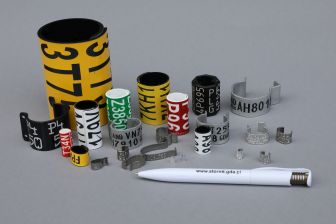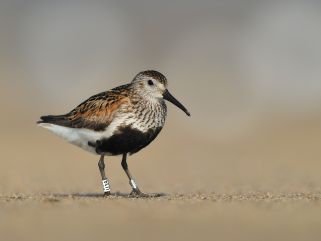Bird ringing
Ringing is one of the widest methods in studying of birds life. It consists on marking of birds with the use of metal rings on the leg of bird. Swans and geese are also marked with bigger, colour neck-collars bearing on the birds' necks; neck-collars are to read from a greater distance.
 | |
fot. Tomasz Mokwa | |
Each ring has imprinted a shortened address of ringing centre, and an individual alpha-numeric code, which - similarly to ID card - identifies an individual, and allows to recognize it even after many years. A comparison of ringing and recovery data provides an information on movements, life span and other aspects of their biology. Serious examination of particular biological aspect of a single species requires usually tens or even hundreds of recoveries. Marking of hundreds of individuals produces only a single recovery - that's why it is so important to inform the ringing centre about the catching, finding or other observation of the ringed bird.
Please - remember !
If you find a ringed bird, contact with Ornithological Station, supporting the following information:
- the whole inscription from the ring,
- if bird is dead, please enclose ring,
- date of finding, catching or observation,
- place of finding, catching or observation,
- status of a bird at the moment of observation (e.g. alive, healthy, freshly dead, decayed),
- the reason of death, if it is possible to determine it,
- the post-catching history of a bird (e.g. released, kept in captivity),
- species of a bird, if possible;
- name and address of the finder - you will get the recovery and ringing data.
The information can be send using an electronic form POLRING'u or by email or post.
Polish Ringing Centre
 | |
fot. Piotr Chara | |
Ornithological Station serves as the national ringing centre under the permission of the Ministry of Environment. It functions as the data bank, collecting and exchanging the information between ringers and - more or less - accidental finders of a ringed birds. All information about our birds recovered abroad arrives here. Data about over 3 million birds marked in Poland since 1931 and over 100,000 recoveries is now held in the data bank. Around 80,000 new birds are ringed in Poland each year and approximately 8,000 recoveries appears yearly. Most of the data is now computerized.
Catching and ringing of birds is mostly driven by co-workers of the Station, who are active individually or in ringing teams in the whole country. Station trains and gives the ringing licenses to the people applying for ringing (license / rights) in Poland, to this end ringing courses are organized. Rings are supplied by the Station.

